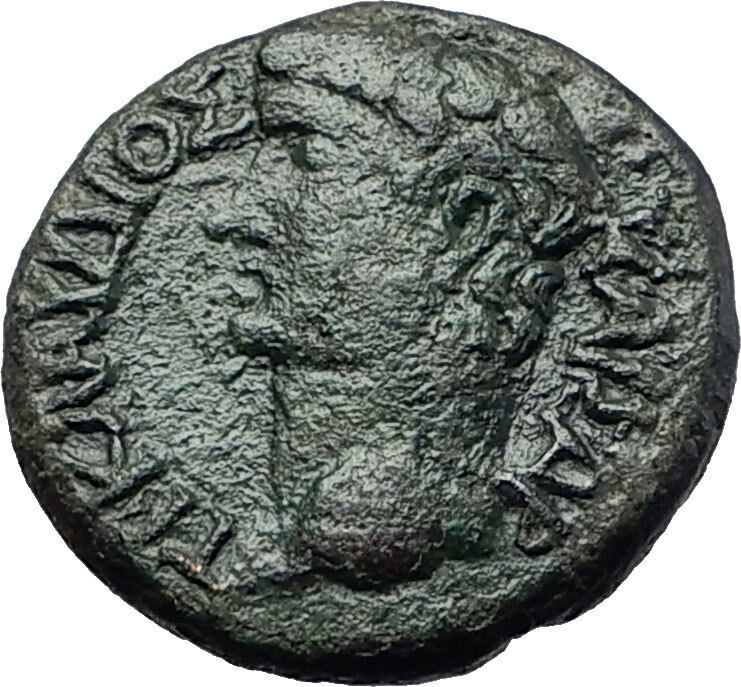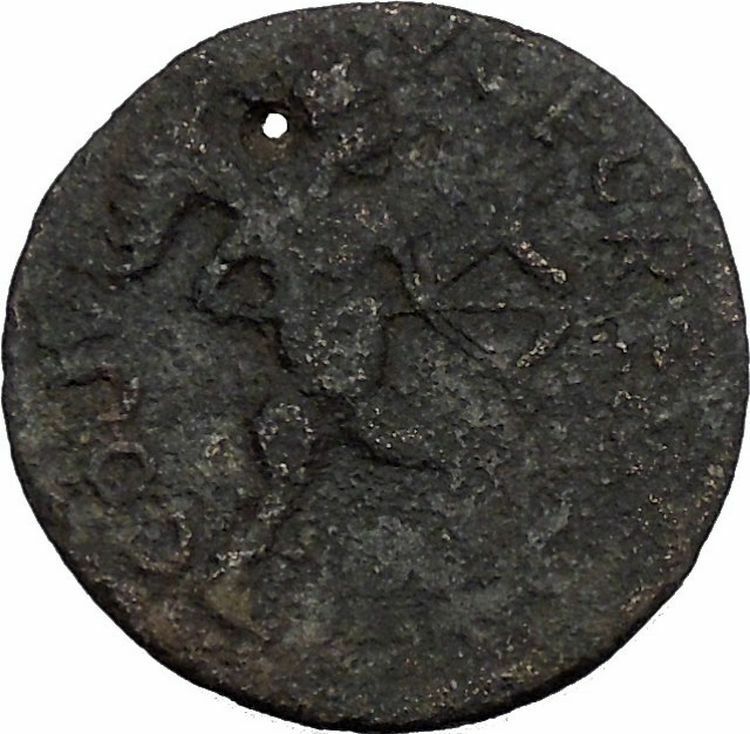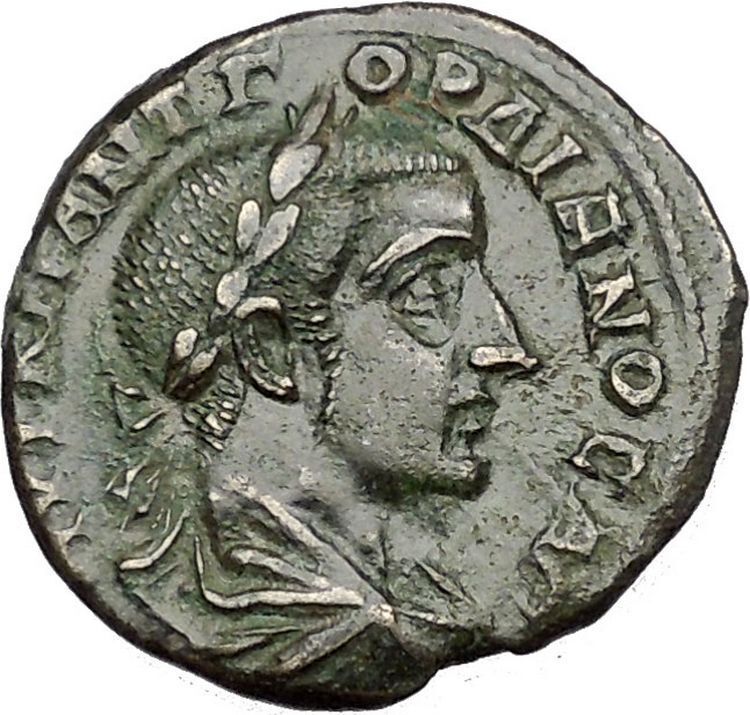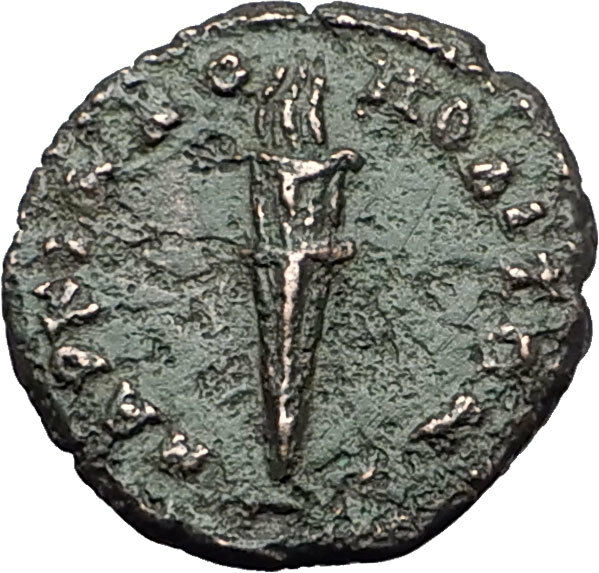|
Antoninus Pius – Roman Emperor : 138-161 A.D.
Bronze Obol 18mm (3.36 grams) of Alexandria in Egypt
Dated Regnal Year 9, 145/146 A.D.
Reference: Köln -; Emmett 1767
AVT. K. T. AIΛ. AΔP. ANTWNINOC, Laureate head right.
L ЄNATOV, Dolphin entwined around trident.
* Numismatic Note: Extremely rare. Emmett cites only one example of this coin, ANS inv. 1934.73.21 (which he lists as 1935-73-21).
You are bidding on the exact item pictured, provided with a Certificate of Authenticity and Lifetime Guarantee of Authenticity.
Alexandria was founded by Alexander the Great in April 331 BC as Ἀλεξάνδρεια (Alexándreia). Alexander’s chief architect for the project was Dinocrates . Alexandria was intended to supersede Naucratis as a Hellenistic center in Egypt, and to be the link between Greece and the rich Nile Valley. An Egyptian city, Rhakotis , already existed on the shore, and later gave its name to Alexandria in the Egyptian language (Egyptian *Raˁ-Ḳāṭit, written rˁ-ḳṭy.t, ‘That which is built up’). It continued to exist as the Egyptian quarter of the city. A few months after the foundation, Alexander left Egypt and never returned to his city. After Alexander’s departure, his viceroy, Cleomenes , continued the expansion. Following a struggle with the other successors of Alexander, his general Ptolemy succeeded in bringing Alexander’s body to Alexandria.
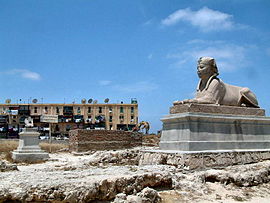
Alexandria, sphinx made of pink granite , Ptolemaic .
Although Cleomenes was mainly in charge of overseeing Alexandria’s continuous development, the Heptastadion and the mainland quarters seem to have been primarily Ptolemaic work. Inheriting the trade of ruined Tyre and becoming the centre of the new commerce between Europe and the Arabian and Indian East, the city grew in less than a generation to be larger than Carthage . In a century, Alexandria had become the largest city in the world and, for some centuries more, was second only to Rome. It became Egypt’s main Greek city, with Greek people from diverse backgrounds.
Alexandria was not only a centre of Hellenism , but was also home to the largest Jewish community in the world. The Septuagint , a Greek translation of the Hebrew Bible , was produced there. The early Ptolemies kept it in order and fostered the development of its museum into the leading Hellenistic center of learning (Library of Alexandria), but were careful to maintain the distinction of its population’s three largest ethnicities: Greek, Jewish, and Egyptian . From this division arose much of the later turbulence, which began to manifest itself under Ptolemy Philopater who reigned from 221–204 BC. The reign of Ptolemy VIII Physcon from 144–116 BC was marked by purges and civil warfare..
The city passed formally under Roman jurisdiction in 80 BC, according to the will of Ptolemy Alexander , but only after it had been under Roman influence for more than a hundred years. It was captured by Julius Caesar in 47 BC during a Roman intervention in the domestic civil war between king Ptolemy XIII and his advisers, and the fabled queen Cleopatra VII . It was finally captured by Octavian , future emperor Augustus on 1 August 30 BC, with the name of the month later being changed to August to commemorate his victory.
In AD 115, large parts of Alexandria were destroyed during the Kitos War , which gave Hadrian and his architect, Decriannus , an opportunity to rebuild it. In 215, the emperor Caracalla visited the city and, because of some insulting satires that the inhabitants had directed at him, abruptly commanded his troops to put to death all youths capable of bearing arms. On 21 July 365, Alexandria was devastated by a tsunami (365 Crete earthquake), an event still annually commemorated 17 hundred years later as a “day of horror.”[4] In the late 4th century, persecution of pagans by newly Christian Romans had reached new levels of intensity. In 391, the Patriarch Theophilus destroyed all pagan temples in Alexandria under orders from Emperor Theodosius I . The Brucheum and Jewish quarters were desolate in the 5th century. On the mainland, life seemed to have centred in the vicinity of the Serapeum and Caesareum , both of which became Christian churches . The Pharos and Heptastadium quarters, however, remained populous and were left intact. In 619, Alexandria fell to the Sassanid Persians . Although the Byzantine Emperor Heraclius recovered it in 629, in 641 the Arabs under the general Amr ibn al-As captured it during the Muslim conquest of Egypt , after a siege that lasted 14 months.
Titus Aurelius Fulvus Boionius Arrius Antoninus (19 September 86 – 7 March 161), generally known in English as Antoninus Pius was Roman emperor from 138 to 161. He was the fourth of the Five Good Emperors and a member of the Aurelii . He did not possess the sobriquet “Pius” until after his accession to the throne. Almost certainly, he earned the name “Pius” because he compelled the Senate to deify his adoptive father Hadrian ; the Historia Augusta , however, suggests that he may have earned the name by saving senators sentenced to death by Hadrian in his later years.
As a private citizen between 110 and 115, he married Annia Galeria Faustina the Elder . They had a very happy marriage. She was the daughter of consul Marcus Annius Verus and Rupilia Faustina (a half-sister to Roman Empress Vibia Sabina ). Faustina was a beautiful woman, renowned for her wisdom. She spent her whole life caring for the poor and assisting the most disadvantaged Romans.
Faustina bore Antoninus four children, two sons and two daughters. They were:
- Marcus Aurelius Fulvus Antoninus (died before 138); his sepulchral inscription has been found at the Mausoleum of Hadrian in Rome.
- Marcus Galerius Aurelius Antoninus (died before 138); his sepulchral inscription has been found at the Mausoleum of Hadrian in Rome. His name appears on a Greek Imperial coin.
- Aurelia Fadilla (died in 135); she married Lucius Lamia Silvanus, consul 145. She appeared to have no children with her husband and her sepulchral inscription has been found in Italy .
- Annia Galeria Faustina Minor or Faustina the Younger (between 125-130-175), a future Roman Empress, married her maternal cousin, future Roman Emperor Marcus Aurelius .
When Faustina died in 141, he was in complete mourning and did the following in memory of his wife:
- Deified her as a goddess.
- Had a temple built in the Roman Forum in her name, with priestesses in the temple.
- Had various coins with her portrait struck in her honor. These coins were scripted ‘DIVAE FAUSTINA’ and were elaborately decorated.
- He created a charity which he founded and called it Puellae Faustinianae or Girls of Faustina, which assisted orphaned girls.
- Created a new alimenta (see Grain supply to the city of Rome ).
Having filled with more than usual success the offices of quaestor and praetor , he obtained the consulship in 120; he was next appointed by the Emperor Hadrian as one of the four proconsuls to administer Italia , then greatly increased his reputation by his conduct as proconsul of Asia . He acquired much favor with the Emperor Hadrian, who adopted him as his son and successor on 25 February, 138, after the death of his first adopted son Lucius Aelius , on the condition that Antoninus would in turn adopt Marcus Annius Verus, the son of his wife’s brother, and Lucius, son of Aelius Verus, who afterwards became the emperors Marcus Aurelius and Lucius Verus (colleague of Marcus Aurelius).
On his accession, Antoninus’ name became “Imperator Caesar Titus Aelius Hadrianus Antoninus Augustus Pontifex Maximus”. One of his first acts as Emperor was to persuade the Senate to grant divine honours to Hadrian, which they had at first refused; his efforts to persuade the Senate to grant these honours is the most likely reason given for his title of Pius (dutiful in affection; compare pietas ). Two other reasons for this title are that he would support his aged father-in-law with his hand at Senate meetings, and that he had saved those men that Hadrian, during his period of ill-health, had condemned to death. He built temples, theaters, and mausoleums, promoted the arts and sciences, and bestowed honours and financial rewards upon the teachers of rhetoric and philosophy .
In marked contrast to his predecessors Trajan and Hadrian , Antoninus was not a military man. One modern scholar has written “It is almost certain not only that at no time in his life did he ever see, let alone command, a Roman army, but that, throughout the twenty-three years of his reign, he never went within five hundred miles of a legion”.[2] His reign was the most peaceful in the entire history of the Principate ; while there were several military disturbances throughout the Empire in his time, in Mauretania , Iudaea , and amongst the Brigantes in Britannia , none of them are considered serious. The unrest in Britannia is believed to have led to the construction of the Antonine Wall from the Firth of Forth to the Firth of Clyde , although it was soon abandoned. He was virtually unique among emperors in that he dealt with these crises without leaving Italy once during his reign, but instead dealt with provincial matters of war and peace through their governors or through imperial letters to the cities such as Ephesus (of which some were publicly displayed). This style of government was highly praised by his contemporaries and by later generations.
Of the public transactions of this period we have scant information, but, to judge by what we possess, those twenty-two years were not remarkably eventful in comparison to those before and after his; the surviving evidence is not complete enough to determine whether we should interpret, with older scholars, that he wisely curtailed the activities of the Roman Empire to a careful minimum, or perhaps that he was uninterested in events away from Rome and Italy and his inaction contributed to the pressing troubles that faced not only Marcus Aurelius but also the emperors of the third century. German historian Ernst Kornemann has had it in his Römische Geschichte [2 vols., ed. by H. Bengtson, Stuttgart 1954] that the reign of Antoninus comprised “a succession of grossly wasted opportunities,” given the upheavals that were to come. There is more to this argument, given that the Parthians in the East were themselves soon to make no small amount of mischief after Antoninus’ passing. Kornemann’s brief is that Antoninus might have waged preventive wars to head off these outsiders.
Scholars place Antoninus Pius as the leading candidate for fulfilling the role as a friend of Rabbi Judah the Prince . According to the Talmud (Avodah Zarah 10a-b), Rabbi Judah was very wealthy and greatly revered in Rome. He had a close friendship with “Antoninus”, possibly Antoninus Pius,[3] who would consult Rabbi Judah on various worldly and spiritual matters.
After the longest reign since Augustus (surpassing Tiberius by a couple of months), Antoninus died of fever at Lorium in Etruria , about twelve miles (19 km) from Rome, on 7 March 161, giving the keynote to his life in the last word that he uttered when the tribune of the night-watch came to ask the password—”aequanimitas” (equanimity). His body was placed in Hadrian’s mausoleum , a column was dedicated to him on the Campus Martius , and the temple he had built in the Forum in 141 to his deified wife Faustina was rededicated to the deified Faustina and the deified Antoninus.
The only account of his life handed down to us is that of the Augustan History , an unreliable and mostly fabricated work. Antoninus is unique among Roman emperors in that he has no other biographies. Historians have therefore turned to public records for what details we know.
Antoninus in many ways was the ideal of the landed gentleman praised not only by ancient Romans, but also by later scholars of classical history, such as Edward Gibbon or the author of the article on Antoninus Pius in the ninth edition of the Encyclopedia Britannicaca:
A few months afterwards, on Hadrian’s death, he was enthusiastically welcomed to the throne by the Roman people, who, for once, were not disappointed in their anticipation of a happy reign. For Antoninus came to his new office with simple tastes, kindly disposition, extensive experience, a well-trained intelligence and the sincerest desire for the welfare of his subjects. Instead of plundering to support his prodigality, he emptied his private treasury to assist distressed provinces and cities, and everywhere exercised rigid economy (hence the nickname κυμινοπριστης “cummin-splitter”). Instead of exaggerating into treason whatever was susceptible of unfavorable interpretation, he spurned the very conspiracies that were formed against him into opportunities for demonstrating his clemency. Instead of stirring up persecution against the Christians, he extended to them the strong hand of his protection throughout the empire. Rather than give occasion to that oppression which he regarded as inseparable from an emperor’s progress through his dominions, he was content to spend all the years of his reign in Rome, or its neighborhood.
|









